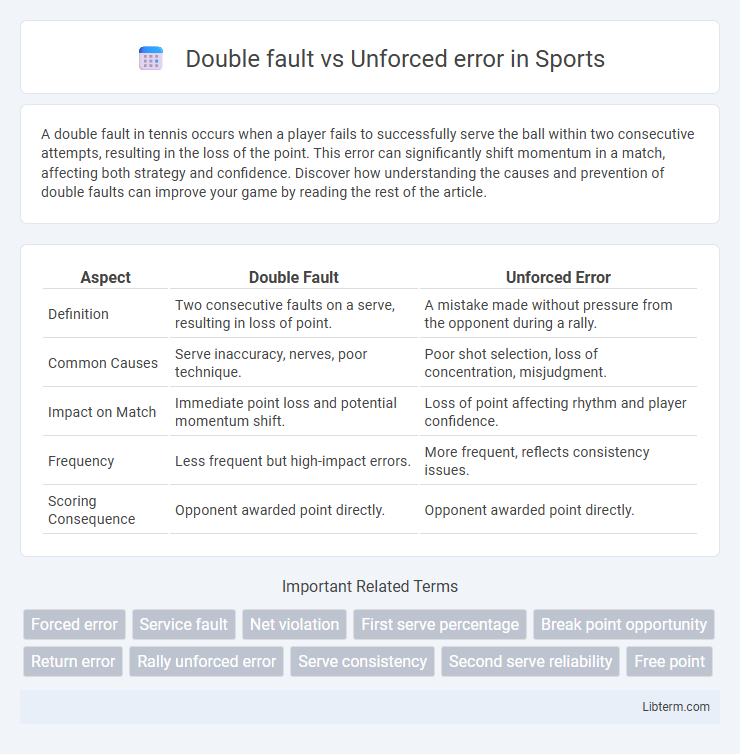A double fault in tennis occurs when a player fails to successfully serve the ball within two consecutive attempts, resulting in the loss of the point. This error can significantly shift momentum in a match, affecting both strategy and confidence. Discover how understanding the causes and prevention of double faults can improve your game by reading the rest of the article.
Table of Comparison
| Aspect | Double Fault | Unforced Error |
|---|---|---|
| Definition | Two consecutive faults on a serve, resulting in loss of point. | A mistake made without pressure from the opponent during a rally. |
| Common Causes | Serve inaccuracy, nerves, poor technique. | Poor shot selection, loss of concentration, misjudgment. |
| Impact on Match | Immediate point loss and potential momentum shift. | Loss of point affecting rhythm and player confidence. |
| Frequency | Less frequent but high-impact errors. | More frequent, reflects consistency issues. |
| Scoring Consequence | Opponent awarded point directly. | Opponent awarded point directly. |
Understanding Double Faults in Tennis
A double fault in tennis occurs when a player fails to land both serves within the designated service box, resulting in an immediate loss of the point. Unlike unforced errors, which happen during regular play without pressure from the opponent, double faults specifically pertain to serving mistakes and directly give the opponent a point. Mastering the serve and minimizing double faults is crucial for maintaining pressure and reducing easy points lost in competitive matches.
Defining Unforced Errors
Unforced errors are mistakes made by a player during a tennis rally that are not directly caused by the opponent's skill or pressure, such as hitting the ball into the net or out of bounds. Double faults, however, occur specifically during service when a player fails to get both serves legally into the service box, resulting in an immediate point loss. Understanding unforced errors is crucial for analyzing player performance and identifying weaknesses unrelated to opponent-induced pressure.
Key Differences: Double Fault vs Unforced Error
A double fault in tennis occurs when a player serves two consecutive faults, resulting in an immediate loss of the point, directly impacting the server's game momentum. An unforced error happens when a player makes a mistake during a rally without significant pressure from the opponent, often reflecting lapses in concentration or technique. Key differences lie in the nature and timing: double faults are serve-related and cause instant point loss, while unforced errors occur during open play and reflect player's performance under less aggressive conditions.
Causes of Double Faults
Double faults primarily occur due to technical flaws in a player's serve mechanics, such as improper toss, lack of rhythm, or poor timing, leading to missed first and second serves. Mental factors like pressure, anxiety, or loss of focus during critical points intensify the likelihood of double faults by disrupting concentration and execution. Unlike unforced errors, which arise from general rally mistakes, double faults are specifically triggered by serve-related issues and mental lapses under stress.
Common Reasons for Unforced Errors
Unforced errors commonly occur due to poor footwork, inconsistent racket preparation, and lack of focus during critical points, leading to unintended mistakes without pressure from the opponent. In contrast, double faults specifically relate to serving and often stem from technical flaws in the toss, grip, or delivery mechanics. Addressing unforced errors requires improving consistency through targeted practice on positioning, shot selection, and maintaining mental concentration.
Impact on Match Outcome
Double faults directly cost players points by giving opponents free points, often shifting momentum and increasing pressure during crucial stages of a match. Unforced errors reflect a player's errors in non-pressure situations, indicating lapses in concentration or technique, which cumulatively weaken performance and provide opponents with scoring opportunities. Matches frequently hinge on the frequency and timing of double faults and unforced errors, as minimizing these mistakes enhances consistency and increases chances of victory.
Strategies to Minimize Double Faults
To minimize double faults in tennis, players should focus on improving serve consistency through targeted practice and proper technique adjustments, emphasizing a controlled toss and smooth racket head speed. Incorporating mental routines and relaxation techniques helps reduce pressure-induced errors during critical points. Using video analysis and feedback allows players to identify mechanical flaws and develop more reliable serve patterns, ultimately reducing the frequency of double faults.
Techniques to Reduce Unforced Errors
Reducing unforced errors involves improving stroke consistency through focused drills that enhance hand-eye coordination and footwork precision. Techniques such as controlled rally practices, maintaining optimal grip pressure, and practicing shot placement under varying court conditions help players minimize miscues. Employing video analysis to identify error patterns further refines technique, leading to a tangible decrease in unforced errors and more effective match performance.
Psychological Factors Affecting Both Errors
Double faults and unforced errors often stem from psychological factors like anxiety, pressure, and loss of concentration. Heightened nervousness can disrupt a player's timing and decision-making, increasing the likelihood of both errors during critical points. Mental fatigue and lack of confidence further exacerbate these mistakes by impairing focus and consistent execution under stress.
Analyzing Pro Player Statistics: Double Faults vs Unforced Errors
Analyzing pro player statistics reveals that double faults directly concede points, significantly impacting serve effectiveness and match outcomes, while unforced errors reflect a player's consistency and mental toughness during rallies. Data shows top players average fewer than 2 double faults per match, but unforced errors can range widely, often exceeding 20, indicating room for improving shot selection and pressure handling. Understanding the balance between minimizing double faults and controlling unforced errors offers strategic insights for enhancing overall performance on court.
Double fault Infographic

 libterm.com
libterm.com